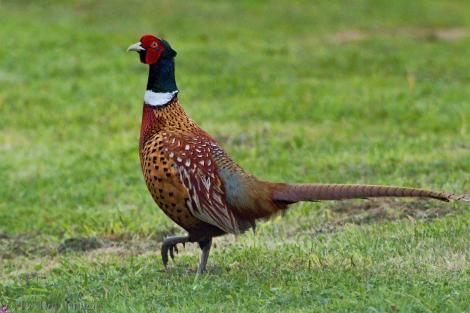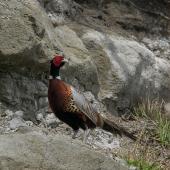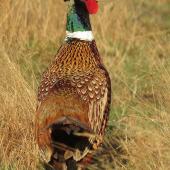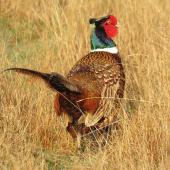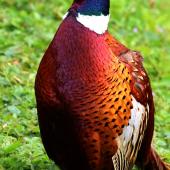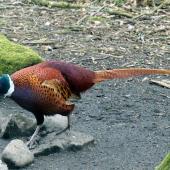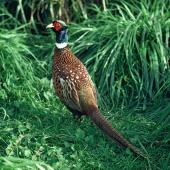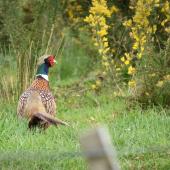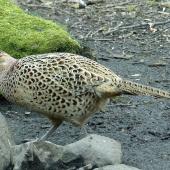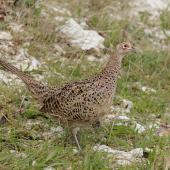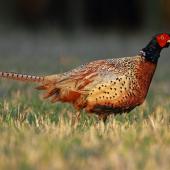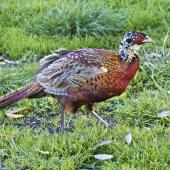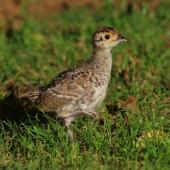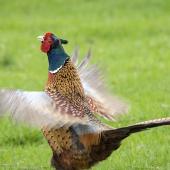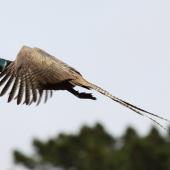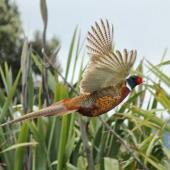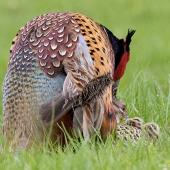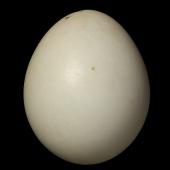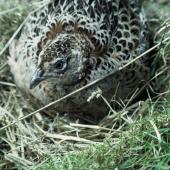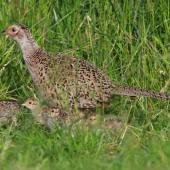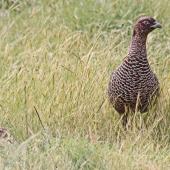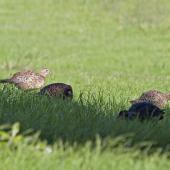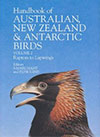Common pheasant
Phasianus colchicus Linnaeus, 1758
Order: Galliformes
Family: Phasianidae
New Zealand status: Introduced
Conservation status: Introduced and Naturalised
Other names: ring-necked pheasant, English pheasant, peihana, Chinese pheasant
Geographical variation: New Zealand stock is a mix of subspecies; the most prominent being the ring-necked pheasant (P. c. torquatus) from China
Acclimatisation Societies released about 30 species of upland game birds throughout New Zealand, to provide sport for European colonists. Common pheasants were among the first to be released, in Wellington, Canterbury, Otago and Auckland from 1842-1877. They are established throughout open country in the North Island, with local populations topped up by ongoing releases by Fish & Game Councils and private breeders. Numbers are lower in the South Island. Hunting of pheasants and other game birds in New Zealand is managed by Fish & Game New Zealand.
Identification
The common pheasant is the largest introduced upland gamebird species established in New Zealand, weighing up to 1.5 kilograms. The male is larger than the female and much more brightly coloured. The most prominent features of the male are its red facial wattle, iridescent blue-green head and neck feathers, distinctive white collar, and long, barred tail feather. The body feathers are red and brown with intricate white margins and black barring. The female is much smaller with a short tail and subtly marked brown feathers with much finer black barring.
Voice: the male has a distinctive loud crow ‘kok-kok’. When flushed, the male utters a loud throaty korrrk alarm call.
Similar species: adult female and immature common pheasants may resemble helmeted guineafowl but lack the bony casque on the head and white-spotted grey plumage. They may also resemble weka and adult female and immature wild turkeys but are distinguished by having long tapering tail feathers and paler brown plumage.
Distribution
Pheasants are most abundant in the northern and western regions of the North Island. In the South Island, it is mainly found in the drier areas of Canterbury and Nelson.
Habitat
In New Zealand, common pheasants inhabit a wide variety of open habitats, including grasslands, arable and pastural farmland, exotic forestry, deciduous woodland, coastal shrubland and road verges. They have a strong association with areas where ink weed is common.
Population
The New Zealand pheasant population is estimated at 250,000 birds, with about 50,000 males shot each year during the winter game-hunting season. Its numbers are augmented through releases of captive-reared birds. Pheasant numbers increased rapidly after their release, but plummeted in the 1890s following the release of ferrets and stoats and widespread laying of poisoned grain, both being measures implemented to control populations of introduced rabbits. Pheasant populations have never fully recovered.
Economic impacts
Pheasants are not recognised as having any significant economic or conservation impacts beyond being a gamebird, with flow-on benefits to suppliers of hunting equipment and licenses.
Breeding
Common pheasants are solitary outside the breeding season. Males are polygamous, mating with a number of females and taking no part in nest building or incubation. The main breeding season is from October to December, but eggs have been found from July to March. The nest is a bowl-shaped indentation in grass, well hidden among vegetation. The average clutch size is 9 with a range of 7-15. Incubation takes 23-28 days; the chicks leave the nest when dry and are able to fly short distances after 12 days.
Behaviour and ecology
Pheasants stay close to vegetation, seeking cover when disturbed. They are wary and have good eye-sight, and so provide few opportunities to observe behaviour other than threat response. When disturbed at close range, they erupt into vertical flight and fly low and swiftly until pitching back into cover.
Food and feeding
Common pheasants are omnivorous, feeding on foliage, seeds, grains, berries and invertebrates. Chicks mainly consume insects. Adults can dig in the ground with their beak and claws up to a depth of 8 cm.
Weblinks
References
Falla, R.A.; Sibson, R.B.; Turbott, E.G. 1966. A field guide to the birds of New Zealand. Collins, London.
Heather, B.D.; Robertson, H.A. 1996. The field guide to the birds of New Zealand. Viking, Auckland.
Lindsey, T.; Morris, R. 2000. Collins field guide to New Zealand wildlife. Harper Collins, Auckland,.
Thomson, G.M. 1922. The naturalisation of animals and plants in New Zealand. Cambridge University Press.
Westerkov, K.E. 1967. Know your New Zealand birds. Whitcombe & Tombs Ltd, Christchurch.
Wilson, K. 2004. Flight of the huia: ecology and conservation of New Zealand’s frogs, reptiles, birds and mammals. Canterbury University Press, Christchurch.
Recommended citation
Seabrook-Davison, M.N.H. 2013 [updated 2017]. Common pheasant. In Miskelly, C.M. (ed.) New Zealand Birds Online. www.nzbirdsonline.org.nz
Common pheasant
- Breeding season
-
- Jul
- Aug
- Sep
- Oct
- Nov
- Dec
- Jan
- Feb
- Mar
- Apr
- May
- Jun
- Nest type
- ground-level hollow
- Nest description
- Bowl shaped indentation in the grass.
- Nest height (mean)
- 0 m
- Maximum number of successful broods
- 2
- Clutch size (mean)
- 9
- Clutch size (min)
- 7
- Clutch size (max)
- 15
- Mean egg dimensions (length)
- 46 mm
- Mean egg dimensions (width)
- 36 mm
- Egg colour
- Olive-brown
- Egg laying dates
-
- Jul
- Aug
- Sep
- Oct
- Nov
- Dec
- Jan
- Feb
- Mar
- Apr
- May
- Jun
- Interval between eggs in a clutch
- Unknown days
- Incubation behaviour
- female only
- Incubation length (mean)
- 25 days
- Incubation length (min)
- 23 days
- Incubation length (max)
- 28 days
- Nestling type
- precocial
- Nestling period (mean)
- Leaves nest within hours of hatching
- Age at fledging (mean)
- Juveniles can fly short distances by 12 days
- Age at fledging (min)
- 12 days
- Age at first breeding (typical)
- Unknown
- Maximum longevity
- 15 years (New Zealand hybrid)
- Maximum dispersal
- Unknown




